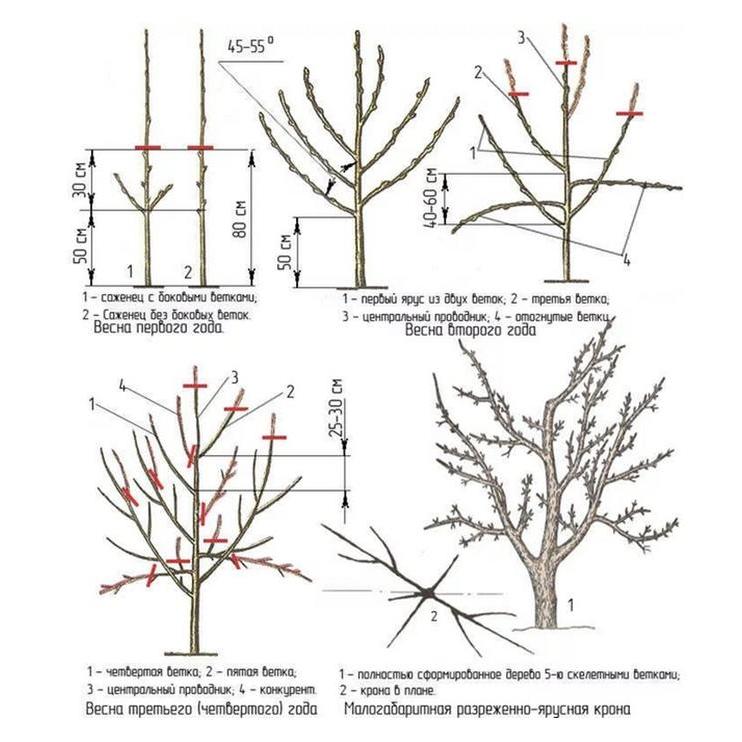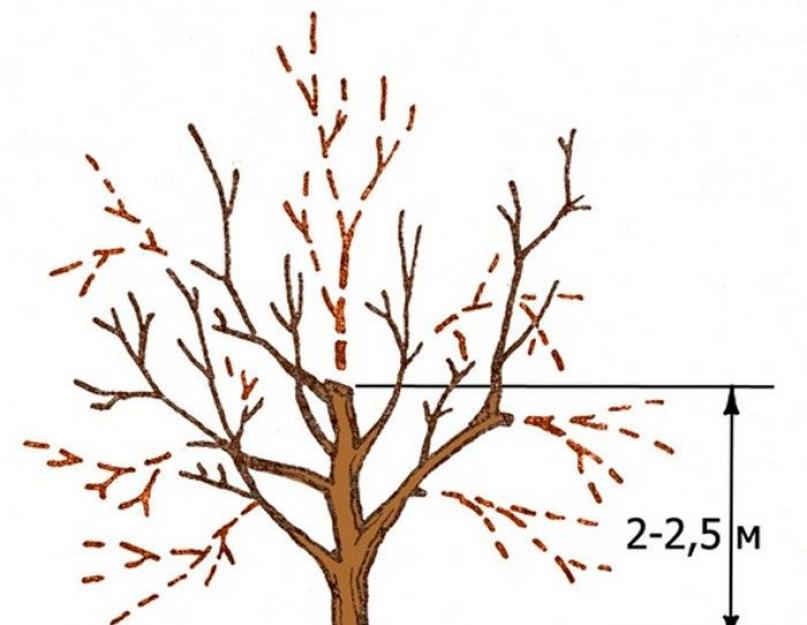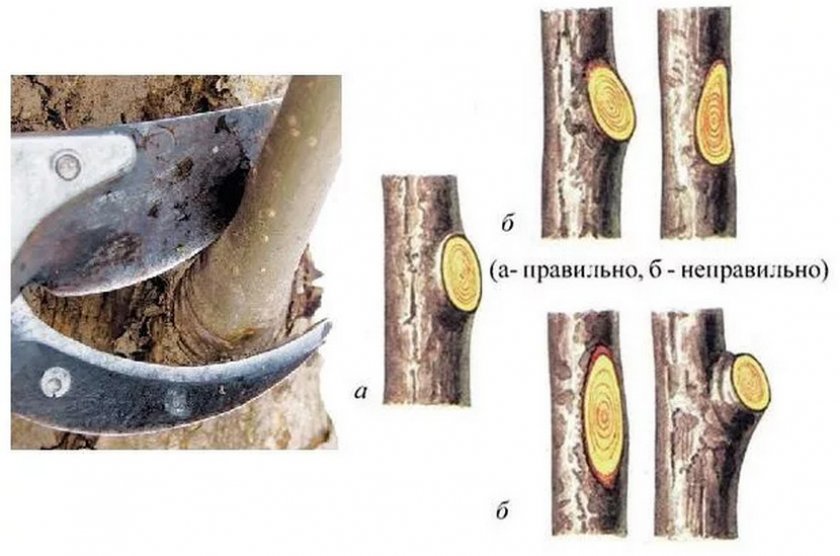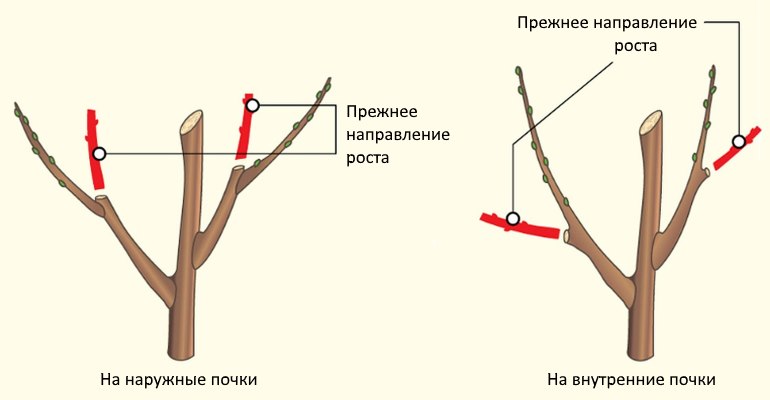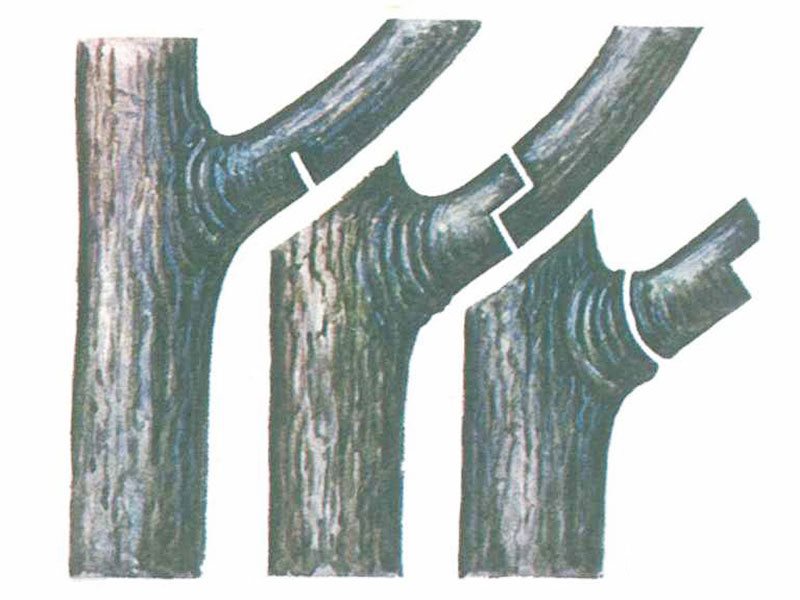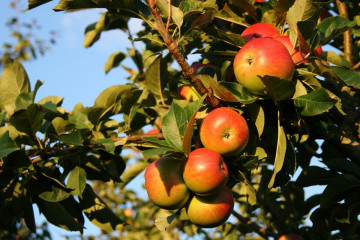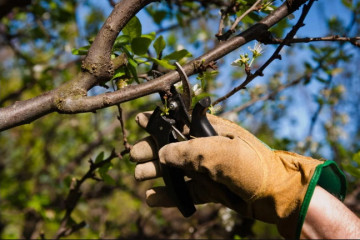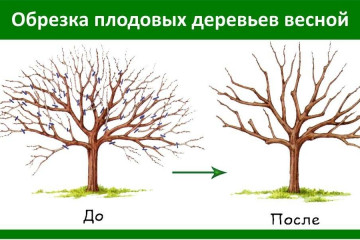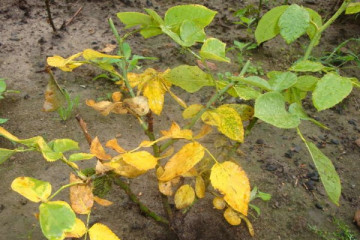Pruning an apple tree in summer and how to do it correctly
Content:
Traditionally, crown formation is carried out in spring or autumn, when the tree is at rest. However, it has been proven that pruning the apple tree in summer can be more beneficial for the trees. The main thing is that the gardener should take into account the basic rules for carrying out work.
Choosing the timing of pruning an apple tree
In spring, gardeners do not always have enough time for sanitary or formative pruning, so the question often arises whether it is possible to prune apple trees in summer. Features of tree pruning in summer:
- June. In late May or early June, the rejuvenation of the apple tree is allowed. Removing old branches allows the shoots to gain access to water and nutrients.
- July. In the middle of summer, it is recommended to pinch the fresh growth on the skeletal branches to slow down the tree's growth rate.
- August. Sanitary pruning is carried out at the end of August. It involves the removal of diseased, dry, old and improperly growing branches. At this time, it is possible to plant young trees in the Moscow region and the central region.
In the summer, technologies such as plucking and breaking are used. Broken branches can be sawed off during the entire period.
The advantages and disadvantages of summer pruning
Summer pruning of young apple and pear trees allows you to carry out work on the correction of the crown, if in the spring time has already been lost. The work does not lead to serious stress and injury to the tree, as it is aimed at cutting or pinching the tops of young shoots.
Experts highlight a number of significant advantages of summer pruning:
- displacement of the flowering period by 1-2 weeks;
- light access to inner branches;
- improved ventilation of the crown;
- improving the appearance and taste of fruits;
- general improvement of trees.
In the summer, it is easier to carry out work for novice gardeners who have not encountered serious tree formation.
The main disadvantages of the procedure include:
- reducing the amount of foliage on the tree;
- an increase in the growing season;
- decrease in yield;
- decrease in the number of fruit buds.
Features of pruning depending on the age of the trees
A high-quality harvest and rapid growth of an apple tree directly depend on its health. To do this, you need to regularly saw the trees. Pruning apple trees under the age of 5 is aimed at creating the correct crown shape and removing damaged branches. Old apple trees are pruned to rejuvenate the tree.
Young seedlings
Young seedlings under 5 years old are recommended to be sawed every year.
Trimming tasks include:
- removal of broken, sick, dried out shoots;
- control of the ratio of the length of the central shoot and side branches.
On a note! During formation, lateral shoots are shortened by an average of 1/3 of the growth.
In the summer, dry and diseased branches, as well as the emerging color, are removed from young apple trees.Flowering and fruiting should not be allowed in two-year-olds. In three-year-old trees, the strongest continuation shoots are left, as well as skeletal branches, which are located 2-3 nodes below them. All other branches are removed.
Trees over 5 years old
Old apple trees need not only formative, but also rejuvenating pruning. The main task during this period is to stimulate the growth of young shoots.
Several factors indicate the need for an update:
- deterioration of the taste characteristics of the fruit;
- decrease in productivity;
- slowdown in the growth of young shoots.
If fruiting has not come, rejuvenating pruning is recommended in the fall after harvest, in September or late summer.
Rejuvenation of old apple trees is carried out in several stages:
- All diseased, withered or broken branches are cut onto the ring.
- All shoots growing inside the crown are cut out.
- The central shoot and the main skeletal branches are shortened by 3-3.5 meters for tall varieties, by 1.5-2 meters for undersized and medium-sized species.
- A uniform thinning of the crown is carried out for access to sunlight, while excess branches are removed.
- The vertical two-year growth (tops) is completely removed.
- Young shoots are pruned to the first large bud; most branches of a two-year growth are pruned to 4 buds.
Before pruning an apple tree, you need to assess its condition and size. Experts note that the maximum yield is given by apple trees, the height of which does not exceed 4 meters. Therefore, the main trunk is shortened so that it does not exceed this value.
Required materials and tools
Gardeners use their hands to pinch or break off branches. But before pruning the large branches of the apple tree, you need to prepare garden tools.
Picture 5 Before trimming, tools should be well sharpened and treated with an antiseptic
To trim you need:
- secateurs;
- lopper;
- garden knife;
- garden saw or hacksaw.
Before use, the tool is sharpened and treated with an antiseptic composition. Glasses and gloves are used to protect eyes and skin.
Pruning rules
Depending on the task at hand, pruning for a ring, for a kidney, rejuvenation or a step-by-step method is used.
On the ring
Ring trimming is used if it is necessary to completely remove the shoot. The branch is cut at the site of the annular bead, which is present at the base of any branch. On the influx there are rapidly multiplying cells that quickly heal the wound.
On the kidney
Bud pruning is used when a branch needs to be shortened. Gardeners distinguish two ways to shorten shoots per bud:
- To the external kidney. It is used when it is necessary to reduce the height of the crown and thin out the center. The branch is trimmed to a bud looking outward from the center of the shoot.
- The inner kidney. It is used when it is necessary to stimulate the growth of young branches or to raise a branch growing downward. The shoot is cut so that a bud remains at the extreme, which looks from the center into the crown.
Thanks to pruning for a bud, gardeners set the desired direction of growth to the branches and form the crown.
Rejuvenation
Anti-aging pruning is only done for trees over 5 years old. It involves a large number of cut branches.Procedure:
- All dried, broken and diseased branches are removed.
- Shoots that do not bear fruit or are competitors to skeletal branches are removed.
- Thinning of the 2-3-year-old growth is carried out.
- Shortening of vertical branches is carried out.
Experts recommend to carry out rejuvenation in several stages. Once pruning is done in the summer, the second time - before the onset of frost or early spring.
Step-by-step method
Step-by-step pruning is used in cases where a dry branch is to be cut without the formation of a hollow. During the procedure, the following instructions are followed:
- A small incision is made from below at a short distance from the barrel ring.
- The same incision is made from above with a slight outward shift, removing the dry branch.
- The remaining stump should be cut down so that the cut is slightly tilted to the northwest.
Features of pruning depending on the type of tree
Features of pruning apple trees in the summer depend not only on age, but also on the type of tree. For tall and medium-sized varieties, general schemes are used for the formation of young and old trees.
Columnar apple trees deserve special attention. When working with them, the main task of pruning is to remove the main fruiting shoot to the two lower shoots. The remaining vertical branches are pinched by 5-7 cm, weak, diseased, dry or excess shoots are cut into a ring.
Follow-up care
Pruning an apple tree is stressful. After the procedure, the tree needs additional care.
In the spring-summer period, after pruning, fertilizers with a high content of nitrogen, phosphorus and potassium should be applied. Ammofoska, saltpeter, urea, diluted chicken manure and mullein have proven themselves well.
If pruning was carried out in late summer or autumn, then preference is given to compositions with a high content of potassium and phosphorus.
After feeding, the trees are watered abundantly with water - 2-3 buckets per square meter.
Methods for replacing cropping
Plucking strong shoots at the end of June is a gentle method for shaping the crown of the tree. It slows down the growth rate of lateral shoots and promotes the formation of fruit buds. Pinching is convenient because it does not require specialized equipment and training. It is used by beginners.
Another alternative way of forming the crown is in the fold. The procedure is carried out in the second half of June. Incorrectly growing branches (internal or growing at an angle) are rejected to a horizontal position. Then they are fixed with twine or tape. The load suspended from it allows you to fix the branch in the desired position.
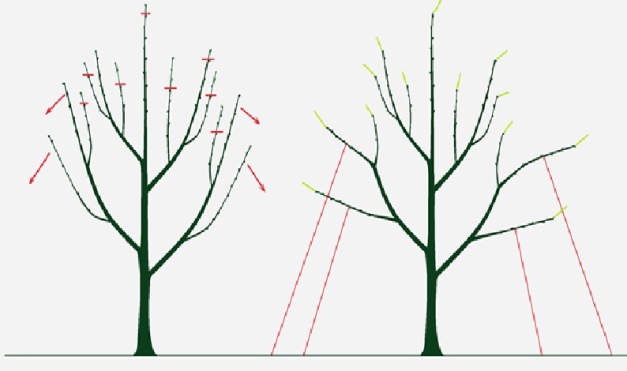
Bending down the inner branches allows you to form a crown without pruning and increase the yield of the tree
The branches remember the new position for 2-3 months. After that, the retainer is removed, the crown continues to be formed in the classical way.
Summer pruning allows for crown formation and stimulates crop growth in the coming year without causing serious damage to the apple orchard.


